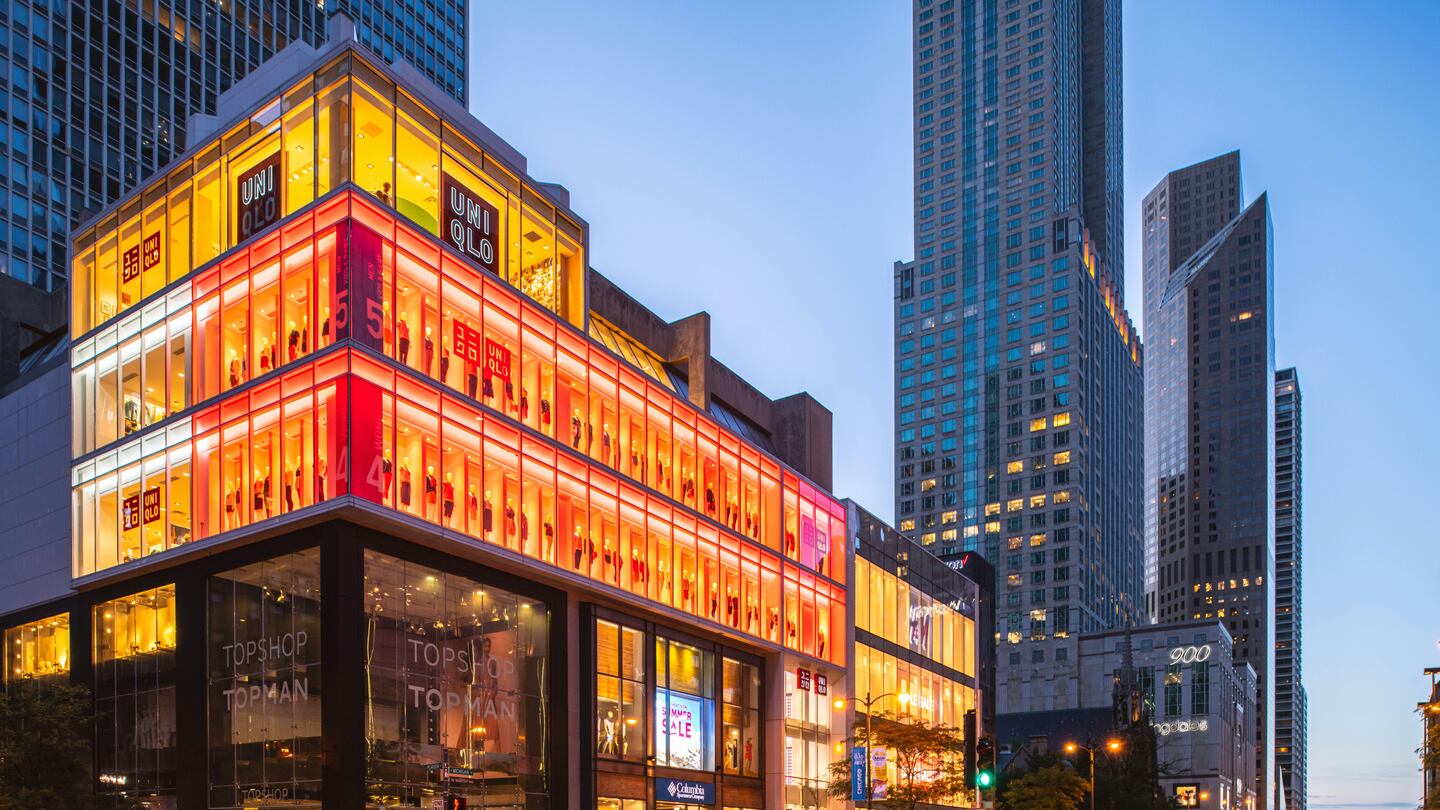
The Business of Fashion
Agenda-setting intelligence, analysis and advice for the global fashion community.

Agenda-setting intelligence, analysis and advice for the global fashion community.

NEW YORK, United States — Brookfield Properties owns 19 percent of the high-quality real estate in the United States, including Ala Moana — one of North America's most valuable retail property in terms of sales productivity. Behind the success of Brookfield Properties is the continuous evolution of the experience at its retail centres that reflects current consumer lifestyle preferences, including managing safety concerns following the Covid-19 pandemic.
Now, as the unprecedented events of 2020 usher in a new age for the retail industry, Brookfield Properties is evolving once again, while facilitating some of fashion’s biggest brands — including some of its most successful digitally native disruptors — to reimagine the role of physical retail in their sales strategies.
According to a new white paper released by the company, A-rated retail continues to outperform digital channels in terms of conversion to purchase rates, which sit around 20 percent for prime physical retail as opposed to e-commerce’s 3 percent. What’s more, in the context of rapidly rising costs to acquire consumers digitally through marketing and advertising spend, the paper argues that physical retail represents an extremely cost-efficient customer acquisition strategy.
To hear more about the white paper’s findings, as well as how 2020 has accelerated the emergence of new ways of connecting with consumers both on- and offline, BoF sits down with Meredith Darnall, Senior Vice President of Business Intelligence and Strategy at Brookfield Properties.

Meredith Darnall Senior Vice President of Business Intelligence and Strategy | Source: Courtesy
How has Brookfield reacted to the unprecedented events that took place in the first half of 2020?
As our properties reopened to our communities, creating a safe environment that follows guidelines from local officials is a primary focus. We are working closely with our communities to ensure that every centre has a customised plan that is catered to the needs of our customers from a shopping and dining perspective, as well as the thousands that work at our centres. Early on, we focused on social distancing; we added safety measures like hand sanitisers, cleaning more frequently, and removed our common area seating. It is simple — we must provide an environment for people to feel comfortable and safe at our centres.
Our secondary response to Covid-19 has been to take a step back and look at retail overall. Not only to see what our consumers are still buying, but how they are buying it. In our conversations with numerous retail brands, we have talked a lot about the importance of a one-channel strategy, and the unique opportunities in those strategies that a successful physical retail business can create moving forward. We have seen an acceleration of the success of Buy-Online-Pick-Up-In-Store (BOPIS) capabilities that retailers are employing. Covid-19 has, on a commercial front, enabled us to test how we can accelerate these capabilities to provide convenience for the consumer, in a responsible and safe environment.
What overarching opportunities have you identified within your partners’ physical retail strategies?
We have shifted our thinking to how our consumers can pick up their goods in an efficient, safe manner, and give our retailer community the opportunity to take inventory from their stores and still be able to sell it. For instance, while our centres were shuttered, we rolled out a curb side pick-up programme across 115 of our centres, enabling brand partners to fulfil orders despite closure, which we will continue long after the pandemic. Our research has shown that 62 percent of consumers who tried BOPIS for the first time in the pandemic plan to use it long after. So, we see a bunch of these capabilities for fulfilment to be very important and lasting, even after the pandemic.
If someone's buying online and picking up in-store, there's always the possibility for that add-on purchase to make the sell even more accretive to top-line growth. BOPIS is much more efficient in terms of cost for our retailers, as well as more accretive to margins and, quite simply, easier to source inventory from stores and fulfil purchases through curb side pick-up, buy online pickup in-store capabilities.
Certain retailers recognised the opportunity very early — even prior to Covid-19 — such as Target, who have a successful and seamless strategy thanks to its commitment and heavy capital investments in this capability. And it's really come to fruition during this time. Sales have predominantly maintained throughout this period because they could allow consumers to access goods during the pandemic, even when the store was closed. From the specialty retailer side, we have seen Nordstrom taking an early lead through heavy investments into its omnichannel capabilities, so that during the Covid-19 lockdowns, sales associates in certain areas had access to a style board, an online clienteling and sales tool technology platform in which they invested in 2018.
How is Brookfield leveraging technological solutions within the physical space to enhance the consumer experience?
In the immediate, for the holiday season, we are implementing a reservation process through a technology called Spot Holder, which will allow consumers to schedule and reserve their shopping times, minimising time waiting and spent in the property.
Previously, the shopping experience was concentrated on the experiential and that’s going to evolve to incorporate digital to again think about how we can service consumers in a convenient but enjoyable manner. So, in addition to establishing curb side pick-up and BOPIS transactions, we also understand that our retailers are focusing on contactless payment to drive efficient payment systems that minimise the touch that goes into an actual transaction.
We also see that retailers will likely move to a ship-from-store strategy. The shipping cost is continuing to grow as digital penetration and online shopping increases, and the cost to ship those items grows with it. That’s not really sustainable for our retailers. So, from talking to our retailers, we understand the logistics of shipping from store to minimise that cost, bringing the product closer to the consumer for a fast and more efficient delivery. We think that will become an important component of a one-channel strategy as we move forward.
Do you believe the opportunity for customer acquisition through physical retail is still significant?
High-quality retail is distinct in that it is often located near the most primed retail consumers. That means people who have both the means and the desire to shop. Because of the proximity to these core consumers, these centres are also able to attract the most compelling retailer brands and services, creating a one-stop shopping destination for the consumer. That breeds loyalty and return visits. If we think about what drives digital conversion, really on digital platforms in terms of discovery, price is the most salient point.
If facilitated within a Covid-secure environment, shopping in-person can allow customers to socialise and get a far more immersive experience with brands than an online or digital platform ever could provide. This level of interaction and in-person experience can create an emotional connection between the customer and the retail brand that is outside of price.
Why are digitally native brands turning to physical spaces within their retail strategies?
Digital fulfilment and customer acquisition costs are sky-high, making physical retail significantly more profitable. Huge increases in digital adoption have coincided with large margin contractions online. Digital customer acquisition costs are the new rent. Digital ad cost has risen 255 percent over the past four years, while rents within Brookfield Properties portfolio have only increased by a comparatively modest seven percent. Retail stores are the best customer-acquisition tools digital natives can invest in, and they come at very low rent.
Proof points utilising Google’s Search Index against store count for previously direct-to-consumer brands like Warby Parker and Peloton shows a direct upward trend in brand sales in correlation to physical store openings. Store closures of challenged retailers positioned Brookfield Properties to gain a disproportionate share of new openings, including digital natives like Warby Parker; and first-to-world openings like Wayfair, which opened at Natick Mall, as well as both B8TA and Table at Crate, at Oakbrook Center. Indeed, we were able to capture 33 percent of Amazon 4-star openings, a leader in e-commerce who has responded to consumer demand for a physical retail experience.
What sets Brookfield’s consumer experience offering apart?
A mall should be about much more than pure retail. It should be about driving a greater experience for our customers, in iconic destinations. Through designing locations that create moments in time, what we call “people-scaping,” we can create a depth of experiences which we believe is fundamental to our customers’ satisfaction and help drive our merchant partners’ success.
For example, we have partnered with some our restaurants to offer dining outdoors, which will continue to evolve with the changing seasons, and we have started hosting drive-in movies and concerts that allow consumers to come in and spend some quality and enjoyable time on the property, in a safe manner. Essentially, we are allowing our partners to use the property space to serve their consumers and patrons in a safe, exciting and effective manner.
We're thoughtful about which retail brands we are partnering with and opening in a property to ensure that they are optimised for the shopper that we have in our local market. We see “people-scaping” as an extension of that curation process. We just want the consumer to come to the centre and feel like it's a seamless experience. It shouldn't feel choppy and shaped only by which brand they choose to visit that day, or which store they choose to enter.
What excites you about the future of Brookfield Properties and retail at large, despite the challenges of Covid-19?
I think there's a lot to be excited about right now. What excites me about the future of Brookfield Properties is really our scale that's going to enable us to reimagine and shape the future retail experience. We have an almost unmatched level of scale — 64 percent of the US population lives within an hour’s drive of one of our properties. In 2019, we had 830 million shopper visits across our portfolio. Our scale alone sets our foundation as a great partner to retail brands, empowers them to acquire consumers and build quality impressions.
But even more than that ability and scale, and our access to capital and expertise across such a huge breadth of real estate, is our ability to help shape the future of retail. It must become much more customer-centric than we've ever seen previously, and there are so many exciting ways that we can partner with our retailers to move beyond the traditional landlord-tenant relationship.
This is a sponsored feature paid for by Brookfield Properties as part of a BoF partnership.
Nordstrom, Tod’s and L’Occitane are all pushing for privatisation. Ultimately, their fate will not be determined by whether they are under the scrutiny of public investors.
The company is in talks with potential investors after filing for insolvency in Europe and closing its US stores. Insiders say efforts to restore the brand to its 1980s heyday clashed with its owners’ desire to quickly juice sales in order to attract a buyer.
The humble trainer, once the reserve of football fans, Britpop kids and the odd skateboarder, has become as ubiquitous as battered Converse All Stars in the 00s indie sleaze years.
Manhattanites had little love for the $25 billion megaproject when it opened five years ago (the pandemic lockdowns didn't help, either). But a constantly shifting mix of stores, restaurants and experiences is now drawing large numbers of both locals and tourists.